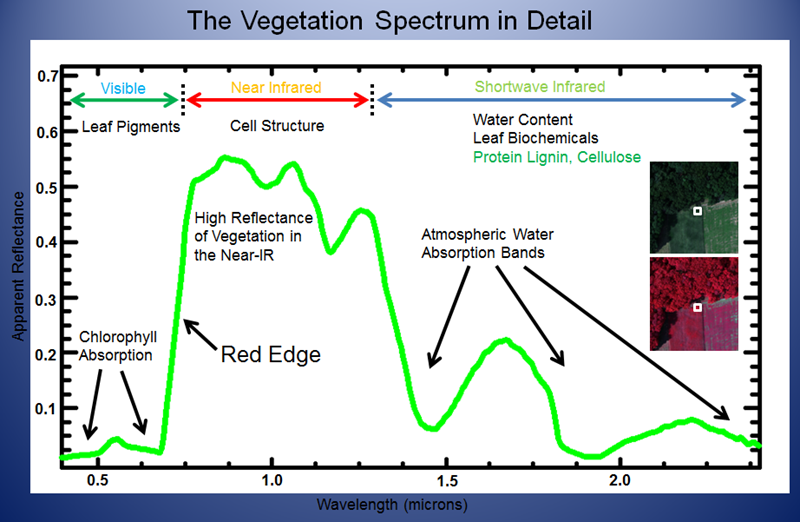Shining a Little Light on Vegetation Indices
Anonym
Vegetation interacts with solar radiation in a different way than other natural materials. The vegetation spectrum typically absorbs in the red and blue wavelengths, reflects in the green wavelength, strongly reflects in the near infrared wavelength (NIR), and displays strong absorption properties in wavelengths where atmospheric moisture is present. The unique properties of vegetation have allowed spectral scientists to develop a number of vegetation indices (VIs) to aid in monitoring the health of vegetation. VIs are combinations of surface reflectance at two or more wavelengths designed to extract useful information about vegetation. More than 150 unique VIs have been developed and published in scientific literature over the past several decades. Many VIs are currently unknown or under-used in commercial, government and scientific communities.

Perhaps the most common, and most often used VI, is the Normalized Difference Vegetation Index (NDVI). The NDVI is a simple, but effective VI for quantifying vegetation. The NDVI normalizes green leaf scattering in the near-infrared wavelength and chlorophyll absorption in the red wavelength. The NDVI is defined by the following equation:
NDVI = (NIR – RED) / (NIR + RED)
NDVI values range from -1 to 1, with the common range for green vegetation falling between values of 0.2 and 0.8. While the NDVI is likely the most common VI, there are a number of other VIs that are worth exploring when using satellite imagery to monitor vegetation. When choosing the appropriate VI to use, it is important to consider what you are interested in getting out of your data. For instance, if you are interested in performing a fire fuel analysis, there are a number of VIs that have been specifically designed to provide an estimate of the amount of carbon in dry states of lignin and cellulose. Dry carbon molecules are present in large amounts in woody materials and senescent, dead, or dormant vegetation. These materials are highly flammable when dry. Dry or senescent carbon VIs use reflectance measurements in the shortwave infrared range to take advantage of known absorption features of cellulose and lignin. One such example of a VI that takes advantage of these features is the Cellulose Absorption Index (CAI). The CAI is useful for identifying exposed surfaces containing dry plant material. CAI is defined by the following equation:
CAI = 0.5(2000nm +2200nm) - 2100nm
The value range of this index ranges from -3 to more than 4, with the common range for green vegetation falling between values of -2 to 4. If you are interested in learning more about VIs and how you can use them to get the information you need from your data, you just might be in luck. I have been working with a colleague to put together a whitepaper that outlines 27 of the most commonly-used VIs and will share it soon!